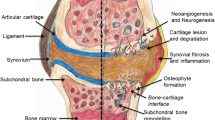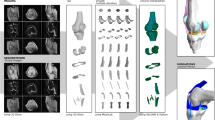Abstract
The use of tissue-engineered cellular constructs is currently under clinical evaluation for the surgical treatment of articular cartilage lesions in the knee. The primary failure mode in such cartilage repair techniques is related to fixation. In addition, the repair tissue is believed to be very fragile in the post-operative period, and unable to support the intra-articular loads. We have developed a laboratory testing protocol in order to quantify the contact pressure distribution that develops on fibrin glue grafts applied to full-thickness cartilage lesions. The contact pressure distribution has been mapped on the contact surface of specimens subject to compression, in three configurations (intact, defect and grafted), at increasing load levels. All the maps show stress concentrations at the rim of the defect and a more uniform stress distribution around the rim after defect grafting. At a contact load of 180 N, the peak contact pressure measured on cartilage is 2.5 MPa. In presence of the graft, the peak pressures on the cartilage area surrounding the defect are reduced by 16%, on average. In contrast, both the mean contact pressure on the graft and the graft’s contact area increase. The graft was found to carry around 80% of the total applied contact load, at all load levels tested. Fibrin glue was chosen as a grafting material in our study because it shows material properties very representative of currently-implanted cellular constructs. Thus, the results of this study have quantified aspects of recipient graft sites that may assist in optimising such grafting procedures from a biomechanical point of view.




Similar content being viewed by others
References
Adam C, Eckstein F, Milz S, Schulte E, Becker C, Putz R (1998) The distribution of cartilage thickness in the knee-joints of old-aged individuals—measurement by A-mode ultrasound. Clin Biomech 13(1):1–10
Ahmad CS, Cohen ZA, Levine WN, Ateshian GA, Mow VC (2001) Biomechanical and topographic considerations for autologous osteochondral grafting in the knee. Am J Sports Med 29(2):201–206
Ann YH and Friedman RJ (1999) Animal models in orthopaedic research. CRC Press, Boca Raton
Bader D, Lee D (2000) Structure-properties of soft tissues: articular cartilage. In: Elices M (ed) Structural biological materials. Pergamon material series. Elsevier, Oxford
Blankevoort L, Kuiper JH, Huiskes R, Grootenboer HJ (1991) Articular contact in a three-dimensional model of the knee. J Biomech 24(11):1019–1031
Brittberg M, Lindahl A, Nilsson A, Ohlsson C, Isaksson O, Peterson L (1994) Treatment of deep cartilage defects in the knee with autologous chondrocyte transplantation. N Engl J Med 331:889–895
Brittberg M, Tallheden T, Sjogren-Jansson B, Lindahl A, Peterson L (2001) Autologous chondrocytes used for articular cartilage repair: an update. Clin Orthop 391(suppl):S337–S348
Brown TD, Pope DF, Hale JE, Buckwalter JA, Brand RA (1991) Effects of osteochondral defect size on cartilage contact stress. J Orthop Res 9(4):559–567
Bruns J, Volkmer M, Luessenhop S (1994) Pressure distribution in the knee joint. Influence of flexion with and without ligament dissection. Arch Orthop Trauma Surg 113(4):204–209
Bujia J, Sittinger M, Minuth WW, Hammer C, Burmester G, Kastenbauer E (1995) Engineering of cartilage tissue using bioresorbable polymer fleeces and perfusion culture. Acta Otolaryngol 115:307–310
Campoccia D, Doherty P, Radice M, Brun P, Abatangelo G, Williams DF (1998) Semisynthetic resorbable materials from hyaluronan esterification. Biomaterials 19:2101–2127
Caplan AI, Elyaderani M, Mochizuki Y, Wakitani S, Goldberg VM (1997) Principles of cartilage repair and regeneration. Clin Orthop 342:254–269
Chen CT, Burton-Wurster N, Borden C, Hueffer K, Bloom SE, Lust G (2001) Chondrocyte necrosis and apoptosis in impact damaged articular cartilage. J Orthop Res 19:703–711
Colombo M, Quaglini V, Raimondi MT, Levi M, Falcone L, Marazzi M, Marinoni E, Remuzzi A, Pietrabissa R (2002) Effects of in vitro culture techniques on the mechanical properties of tissue-engineered cartilage: a rheological study. In: Middleton J, Shrive NG, Jones ML (eds) Computer methods in biomechanics and biomedical engineering, vol 4. University of Wales College of Medicine, UK. ISBN: 1-903847-08-5
Fukubayashi T, Kurosawa H (1980) The contact area and pressure distribution pattern of the knee. A study of normal and osteoarthrotic knee joints. Acta Orthop Scand 51(6):871–879
Gille J, Ehlers EM, Okroi M, Russlies M, Behrens P (2002) Apoptotic chondrocyte death in cell-matrix biocomposites used in autologous chondrocyte transplantation. Ann Anat 184(4):325–332
Grande DA, Breitbart AS, Mason J, Paulino C, Laser J, Schwartz RE (1999) Cartilage tissue engineering: current limitations and solutions. Clin Orthop 367(suppl):S176–S185
Huang A, Hull ML, Howell SM (2003) The level of compressive load affects conclusions from statistical analyses to determine whether a lateral meniscal autograft restores tibial contact pressure to normal: a study in human cadaveric knees. J Orthop Res 21(3):459–464
Hutmacher DW (2000) Scaffolds in tissue engineering bone and cartilage. Biomaterials 21:2529–2543
Loening AM, James IE, Levenston ME, Badger AM, Frank EH, Kurz B, Nuttall ME, Hung HH, Blake SM, Grodzinsky AJ, Lark MW (2000) Injurious mechanical compression of bovine articular cartilage induces chondrocyte apoptosis. Arch Biochem Biophys 381(2):205–212
Nelson BH, Anderson DD, Brand RA, Brown TD (1988) Effect of osteochondral defects on articular cartilage. Contact pressures studied in dog knees. Acta Orthop Scand 59(5):574–579
Raimondi MT, Falcone L, Colombo M, Remuzzi A, Marinoni E, Marazzi M, Rapisarda V, Pietrabissa R (2004) A comparative evaluation of chondrocyte/scaffold constructs for cartilage tissue engineering. J Appl Biomat Biomech 2:35–64
Simonian PT, Sussmann PS, Wickiewicz TL, Paletta GA, Warren RF (1998) Contact pressures at osteochondral donor sites in the knee. Am J Sports Med 26(4):491–494
Stading M, Langer R (1999) Mechanical shear properties of cell-polymer cartilage constructs. Tissue Eng 5(3):241–250
Acknowledgements
This paper is based on a thesis work conducted by MS students Luca Pietrolungo and Francesco Yunginger. We are very grateful to Maurizio Colombo, Ph.D., for his excellent technical assistance and to Enzo Marinoni, MD, for fruitful discussion regarding the clinical aspects. The experiments described in the paper comply with the Italian laws currently in force.
Author information
Authors and Affiliations
Corresponding author
Rights and permissions
About this article
Cite this article
Raimondi, M.T., Pietrabissa, R. Contact pressures at grafted cartilage lesions in the knee. Knee Surg Sports Traumatol Arthrosc 13, 444–450 (2005). https://doi.org/10.1007/s00167-004-0529-1
Received:
Accepted:
Published:
Issue Date:
DOI: https://doi.org/10.1007/s00167-004-0529-1




